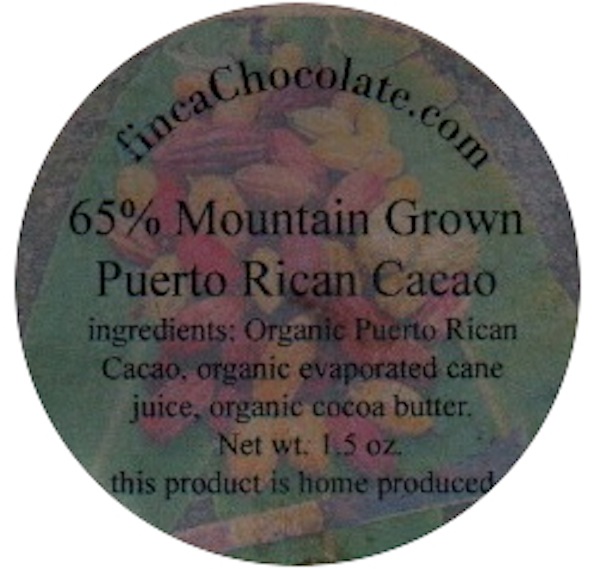Mountain Grown Puerto Rican Cacao
by fincaChocolate
Impact
THE FOLLOWING REVIEW PERTAINS TO AN EARLY RELEASE PROTOTYPE. IN KEEPING WITH the C-spot's® 2 KEWL 4 SKOOL POLICY, IT IS UNRATED. BUT BECAUSE OF ITS UNDERSERVED ORIGIN, WHOSE CACÁO GROVES ARE IN FLUX, IT MERITS COVERAGE.
*****************************************************
With this bar one more cacáo source can be added to the map. One heretofore untasted by just about,… well, everyone: Puerto Rico. Dan Hankle of fincaChocolate introduces the premium market to this Caribbean island’s bounty (local barsmiths like Cortés, Jean Marie, Loizadark, et.al. rarely export).
O.W. Barrett wrote in 1925 an article titled The Food Plants of Porto Rico in which he dates the first attempts of cacáo cultivation there to 1626.
With reputed Criollo seeds transplanted from the State of Mérida in Venezuela, they bore green pods with white cotyledons, rather homogenous / self-compatible.
By the end of the 17th century more from Venezuela arrived, specifically from Trujillo along Lake Maracaibo just north of Mérida, of hybrids & a type Barrett listed as ‘Calabacillo’, a collection sporting red & green pods.
Those initial trees failed to establish any permanent production due to better opportunity costs from other crops – a tale eerily familiar to modern day competition from bananas, palm oil, & even rubber.
All’s not lost… show more »
With this bar one more cacáo source can be added to the map. One heretofore untasted by just about,… well, everyone: Puerto Rico. Dan Hankle of fincaChocolate introduces the premium market to this Caribbean island’s bounty (local barsmiths like Cortés, Jean Marie, Loizadark, et.al. rarely export).
O.W. Barrett wrote in 1925 an article titled The Food Plants of Porto Rico in which he dates the first attempts of cacáo cultivation there to 1626.
With reputed Criollo seeds transplanted from the State of Mérida in Venezuela, they bore green pods with white cotyledons, rather homogenous / self-compatible.
By the end of the 17th century more from Venezuela arrived, specifically from Trujillo along Lake Maracaibo just north of Mérida, of hybrids & a type Barrett listed as ‘Calabacillo’, a collection sporting red & green pods.
Those initial trees failed to establish any permanent production due to better opportunity costs from other crops – a tale eerily familiar to modern day competition from bananas, palm oil, & even rubber.
All’s not lost… show more »
Appearance -- / 5
| Color: | antho-brown ("purpling" dark from anthocyanin) |
| Surface: | good print |
| Temper: | dignified |
| Snap: | click-clack |
Aroma -- / 10
hopping mad… hop 'n yeast
spice struggles to breakthru cracks in the quarry beneath
dried white strip-bark (laurel-like)
then at the higher altitude those hops 'n yeast proliferate shades of Adi's beer hall but singular of sorts at these concentrations
spice struggles to breakthru cracks in the quarry beneath
dried white strip-bark (laurel-like)
then at the higher altitude those hops 'n yeast proliferate shades of Adi's beer hall but singular of sorts at these concentrations
Mouthfeel -- / 15
| Texture: | granular |
| Melt: | longer than anticipated |
Flavor -- / 50
frothy yeast beginning -> soiled & bittered cocoa -> malt -> pale ale -> lite cinnamon spike -> rear cashew
Quality -- / 20
Dan Hankle of fincaChocolate out of Logan, OH owns a 5 acres parcel in Puerto Rico where he tends to cacáo trees still awaiting fruition. In the meantime he relies on his island neighbors Lugo & José to supply his needs for this bar. They cultivate a "hodge-pod" of seedling trees. The seeds originated from Hacienda Buena Vista -- a local coffee & cacáo estate. Buena Vista's cacáo seeds in turn came from the USDA Research Center at Mayaguez to bring the story full circle from/to the beginning. In other words, non-Criollo because the USDA Station never possessed it before Stephanie Cosme's survey.
Instead, Dan works an admixture which includes 2 main types: a) deeply ridged, pointed apex that startt as a purple & finish red & whose pulp tastes tart & sweet & b) smoother pods containing lots of juicy, sweeter pulp of milder flavor.
Remarkably, he fermented this batch back in Ohio! Unsurprisingly, this tastes well under-fermented as the bacteria never really develop into reducing sugars for acidification during such a low-temp ferment. Issues further compounded by possible drying challenges. Ergo, the relatively high cane sugar-content to compensate.
Easy enough to discern, however, that Puerto Rica hosts some kind cacáo, perhaps on the non-complex side, but too early to assess that just yet.
An origin of probable friendly characteristics once the breeding & post-harvest methods are resolved.
INGREDIENTS: cocoa mass, sugar, cocoa butter
Reviewed November 21, 2014
Instead, Dan works an admixture which includes 2 main types: a) deeply ridged, pointed apex that startt as a purple & finish red & whose pulp tastes tart & sweet & b) smoother pods containing lots of juicy, sweeter pulp of milder flavor.
Remarkably, he fermented this batch back in Ohio! Unsurprisingly, this tastes well under-fermented as the bacteria never really develop into reducing sugars for acidification during such a low-temp ferment. Issues further compounded by possible drying challenges. Ergo, the relatively high cane sugar-content to compensate.
Easy enough to discern, however, that Puerto Rica hosts some kind cacáo, perhaps on the non-complex side, but too early to assess that just yet.
An origin of probable friendly characteristics once the breeding & post-harvest methods are resolved.
INGREDIENTS: cocoa mass, sugar, cocoa butter
Reviewed November 21, 2014




